You could argue that the Thrustmaster T598 has been timed to perfection.
This is the latest PC and PlayStation-compatible sim racing bundle to contain a steering wheel, pedals, and a direct drive wheelbase. Except, it isn’t actually direct drive… At least, not as we know it.
DAD Tech
This base utilises a new type of technology known as direct axial drive. Without going into the sort of detail I am unqualified to cover, this means the base contains an axial flux motor, rather than a traditional radial flux motor.
If more torque for less material and size is what you are after, then axial is, in theory, the ideal solution. In comparison, it’s more scalable, more efficient, requires less material and doesn’t rely on a lengthy motor to produce higher torque figures. Of course, it’s not all about torque; there are other differences too, but those I will get to later.
Based on the science behind it, the T598 should produce a better torque-to-cost ratio. But does that translate to strong, tangible consumer value?
Cost
This bundle will set you back £449.99 in the UK, or 499.99 if you are paying in Euros or US Dollars. That seems very competitive considering the theoretical performance, its PlayStation compatibility and what’s included.
The 5 Nm DD Pro bundle from *gulp* Fanatec for instance; with its base, wheel and pedals, willset you back $699.95. Yes, you can get a cheaper DD Fanatec bundle for PC and even Xbox, but not PlayStation. Plus you would have to pay extra for a table clamp should you need it, which is included in the Thrustmaster package.
The T598 bundle sits neatly between popular entry-level gear and belt-driven offerings and the more powerful direct drive bundles that populate the premium side of the market.
This certainly feels like Thrustmaster replacing its T-GT II… I say replacing, it’s more like obliterating it from the earth’s surface.

All About That Base
The inevitable star of the show here has to be the base itself. Due primarily to the new technology and the lack of need for a lengthy shaft, it has its own unique hexagonal shape, which I like. It’s taller than any wheelbase I have ever used before, and this creates its own complexities for rig users in particular, who may have to significantly alter the positioning of any monitors. For desk users, however, it’s arguably a benefit. All of the cableage is channelled directly out of the back too, keeping things neat and tidy.
The T598 uses the same quick release as the existing T818 and is compatible with other wheels from the existing Thrustmaster ecosystem, so long as you have purchased and installed the quick-release upgrade for any older wheels. Another notable feature of the base is the screen at the top, which provides telemetry data depending on the game and platform and can be used to adjust performance settings on the fly.
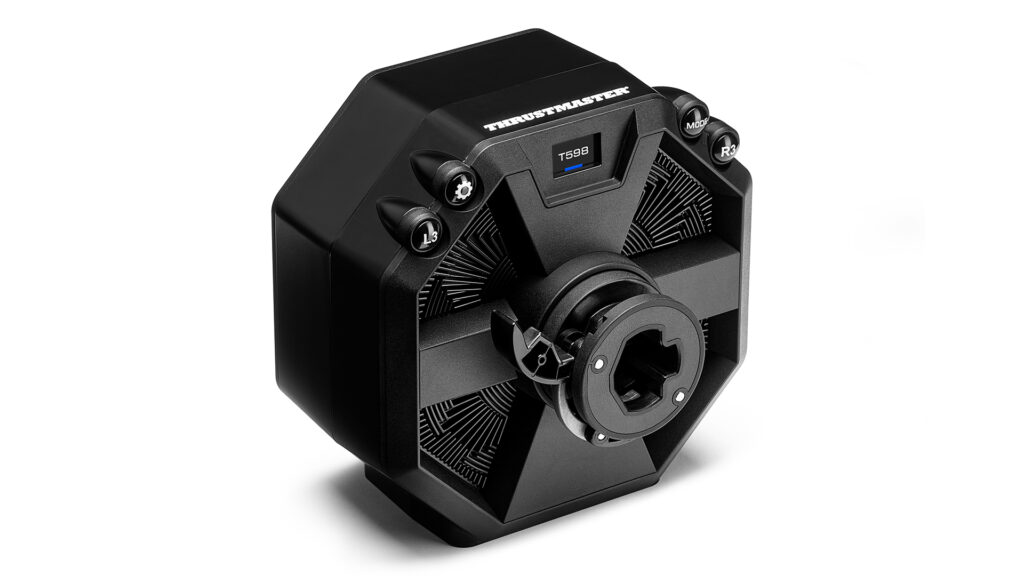
How does the base perform?
Whilst the torque level, in a traditional sense, sits around the 5 Nm mark, this base is actually capable of peaking at a much higher level, albeit, for brief moments rather than sustained periods. This is thanks to something Thrustmaster is labelling ‘controlled overshooting’ made possible by its axial technology and the subsequent lack of ‘cogging’.
What you need to know is, that whilst in general use (ie: regular cornering and loading up the tyres), the base performs admirably relative to its DD rivals and the force feedback stands out when the detail is called upon. Road textures are as clear and crisp as a Royal Philharmonic Orchestra performance, and when you begin to lose the rear of the car, the feedback feels instantaneous.
There were numerous occasions when I was on the brink of disaster, convinced I was a goner, only to bring it all back under control before I could even comprehend what I was feeling.
Of course, when we discuss force feedback through direct drive sim racing hardware, we are talking about subtle differences rather than transformative experiences between the various offerings. It’s the same here generally speaking, but with some notably positive exceptions when it comes to the finer, instantaneous details.
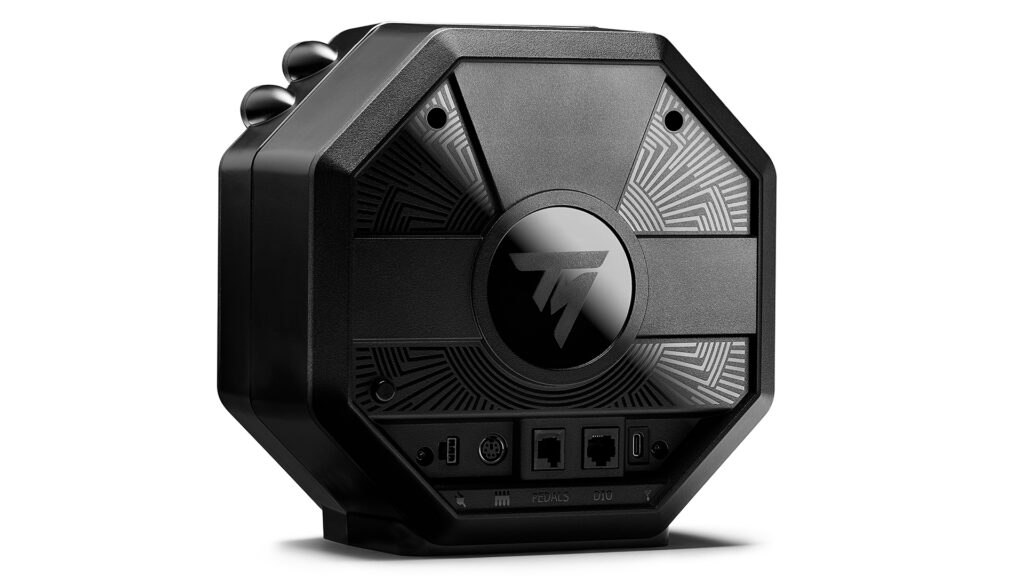
Having said that, whilst the overshooting may eliminate traditional clipping and contribute to heavier more reactive feedback in certain instances, the boosts are so momentary that it won’t exactly feel like your T598 has just turned into a T818.
On the force feedback front, one area I felt underwhelmed by was the sensation over kerbs. Given the clarity and the textured feel to surfaces in general, I was hoping for a bit of a clobbering. However, a surprisingly impactful feature comes in the form of gear jolt. When set to high, vibration is sent through the base on every gear change, and this jolt can be felt through the seat when using an aluminium profile rig. I tried it, turned it off and really missed it. It definitely adds something to the overall experience.
So overall, its force-feedback quality and power is exemplary, considering the cost. But what about the other stuff?
Notable Characteristics
The T598 does make more noise than other direct drive bases on the market, a whine from the electric motor during quick oscillations being the most discernible, which gets louder as you ramp up the feedback settings.
That being said, you can’t hear this noise when wearing decent headphones, and overall it’s still quieter than most entry-level gear and belt-driven bases. It also emits a reasonable amount of heat; not enough to be concerning, but enough when combined with the noises to give you the perception the base is working hard.
The 300mm diameter Sportcar Steering Wheel is a jack-of-all-trades, master of none. Whilst its simple sleek appearance is inoffensive, its magnetic aluminium paddles functional and its round shape practical and versatile, it doesn’t evoke any sort of excitement.
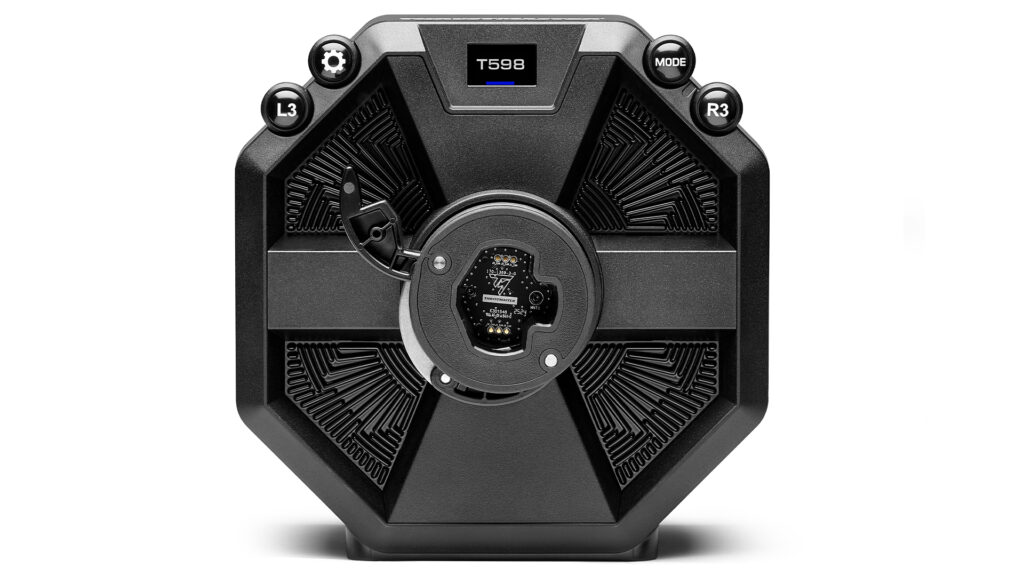
If anything, this is one of the areas where compromises are clear to keep the overall cost as low as it is. The buttons for instance feel relatively cheap, and actuation can be sub-optimal when quickly navigating menus. There are no rotary encoders or fancy dials, just the required PlayStation inputs and one button-based encoder with another button to cycle through ‘tabs’.
These are individually programmable on PC too, so you can still have specific buttons mapped for brake bias, traction control and engine maps, for example, and you do have to click extra buttons to find what you need. In the heat of battle, this can leave you distracted and scrambling. This is an understandable compromise, but a compromise nonetheless.
I do, however, like the feel of the wheel in the hands. Despite its plastic construction, the rubber grips and simple indentations for your thumbs make it comfy over longer stints and leave no irritation or perceivable pressure points.
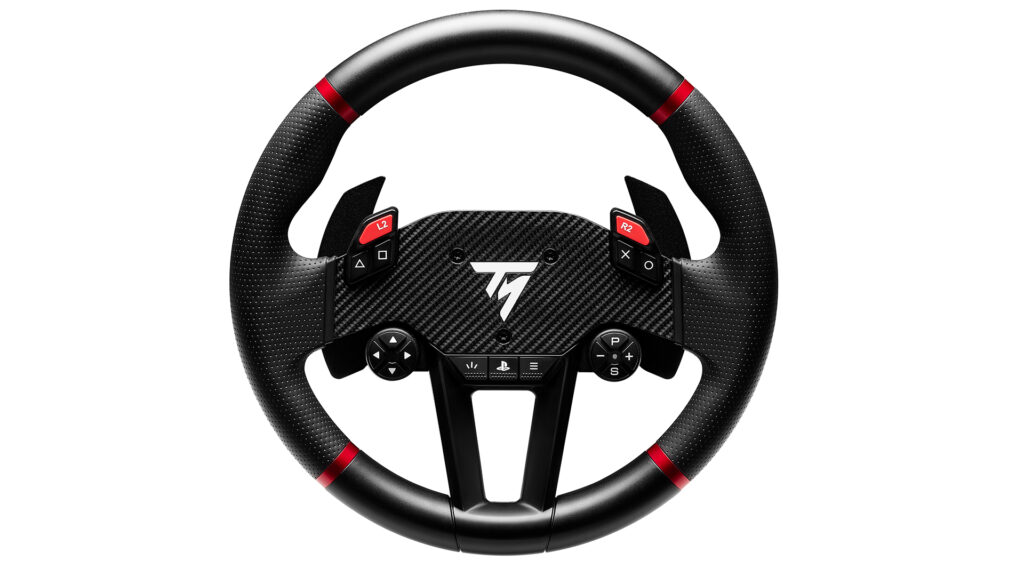
The Screen
Having the ability to change feedback settings whilst driving is a positive too. Being able to feel exactly what each subtle change is doing as you are driving, allows you to learn what the base is capable of across different platforms whilst avoiding the painstaking process of in-and-out software adjustments.
The same screen is also used for the live telemetry, and the report here is less glowing. Instead of being able to cycle through relevant telemetry tabs with the use of one button, you have to access a menu with all of the telemetry types and then select the format that you want on the screen each time.
This makes it impractical to switch during a competitive race, and as each game has its own telemetry compatibility, you will find yourself selecting options that don’t yet work for the specific game you are playing. If you just choose an available format before the race, however (such as speed, gear or position), and stick to it, things will be just fine.
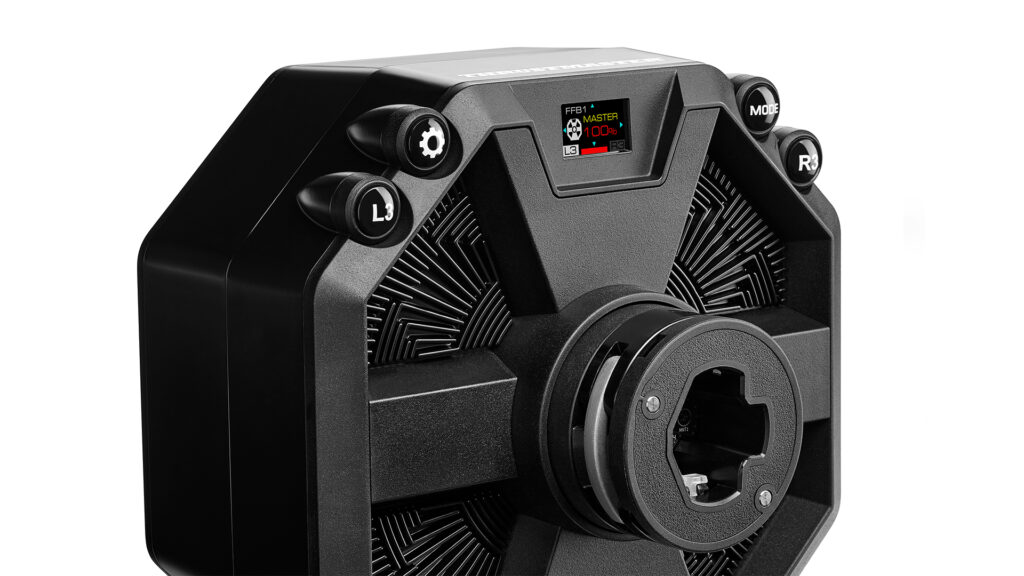
Pedals
The pedals signify the start of much-needed progress in this particular area of the Thrustmaster ecosystem. The modular Raceline LTEs included in the bundle are the entry-level offering within the upcoming Raceline range and consist of a basic metal two-pedal setup, with a metal base plate and plastic faceplates.
Thankfully, these will be upgradeable in future for anyone who wants a three-pedal setup or a load-cell brake upgrade kit (yes, these don’t come with a load-cell, instead utilising the same proprietary H.E.A.R.T technology found in its existing T3PM’s bundled with the T248).
All of this reminds me of the Fanatec CSL pedals, and with a sub-£100 price point confirmed for when these go on sale individually later this year, it matches up. This really is no bad thing, as when compared to the existing Thurstmaster price point equivalent, these are nicer to look at, better to use, and you can make a reasonable number of adjustments (from springs to pedal positions), incredibly easily. They also come with clip-on grips that will prevent sliding on carpets, a nice touch.
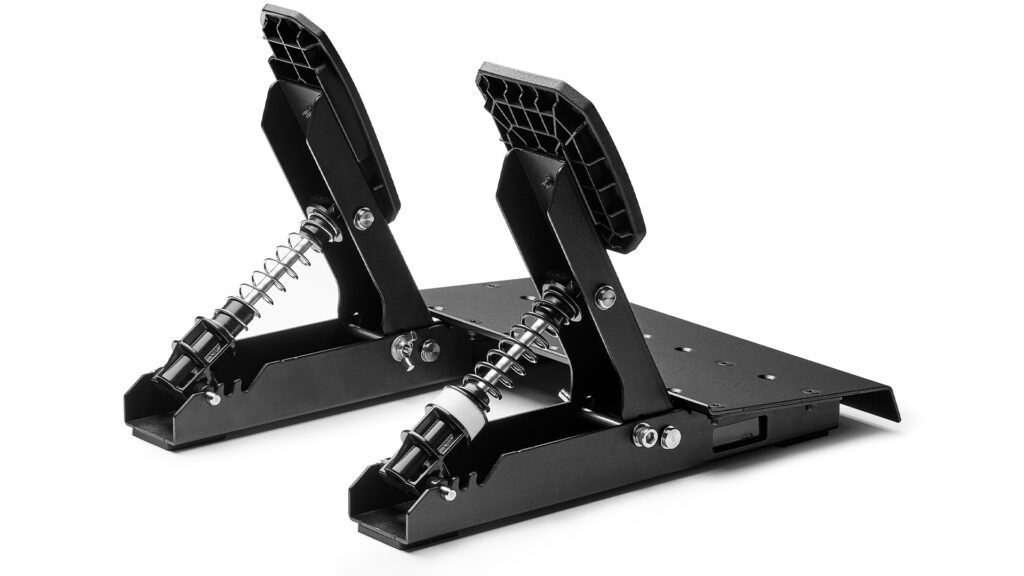
The other good news is the commendable performance. For any racing title where crude braking techniques are endorsed, you will of course have no problems, but even on hardcore sims which require a deft touch, consistent braking is more than manageable.
Using the stiffest spring, I was able to avoid lock-ups on iRacing and maintain decent stopping power lap after lap. Without a load-cell setup, you are relying more on feel and precision than muscle memory, but unless you are competing at the highest level of esports competition, these LTEs will be more than adequate to see you through until you choose to upgrade in future.

Closing Thoughts
Overall, this is a mightily impressive bundle that punches above its weight with regard to performance. It’s easy to throw around engineering buzzwords to try and make new technology sound impressive, but what’s actually impressive is how those theories translate to relatable reality.
To achieve such a competitive price for how good the force-feedback is, there have to be compromises. But I feel those compromises have been made in sensible ways, mostly on areas that can be upgraded in future such as the steering wheel and the pedals.
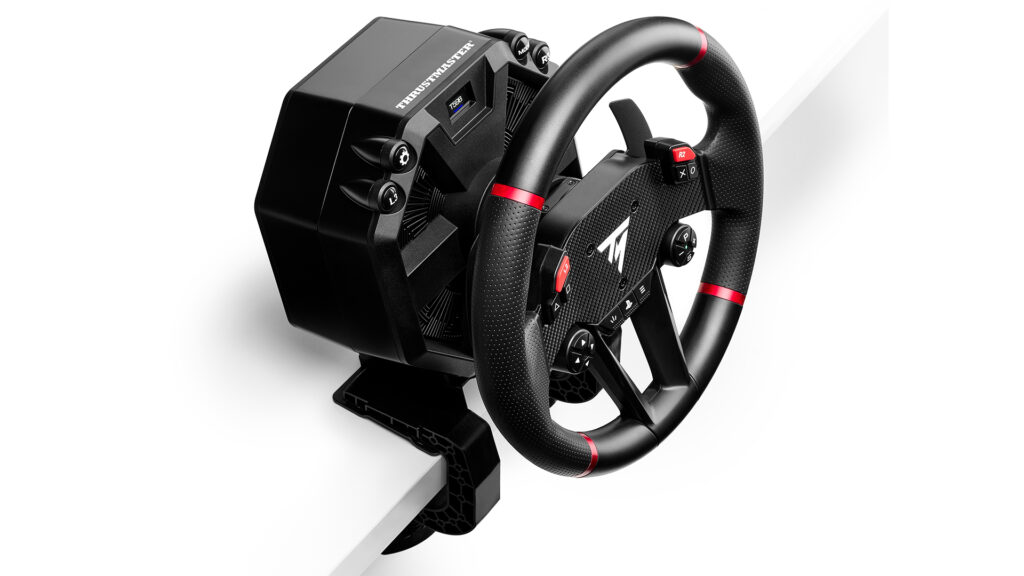
Value-wise, you will struggle to find something that packs so much punch per pound. For sim racers, the feedback clarity and strength puts it far ahead of existing entry-level bundles, but close behind premium offerings that are often more than double the price. If you are looking to take your sim racing as seriously as you take your finances and care about performance over ostentation, you need look no further.
Full disclosure: This product was provided by the manufacturer for review purposes. Here is our review policy.
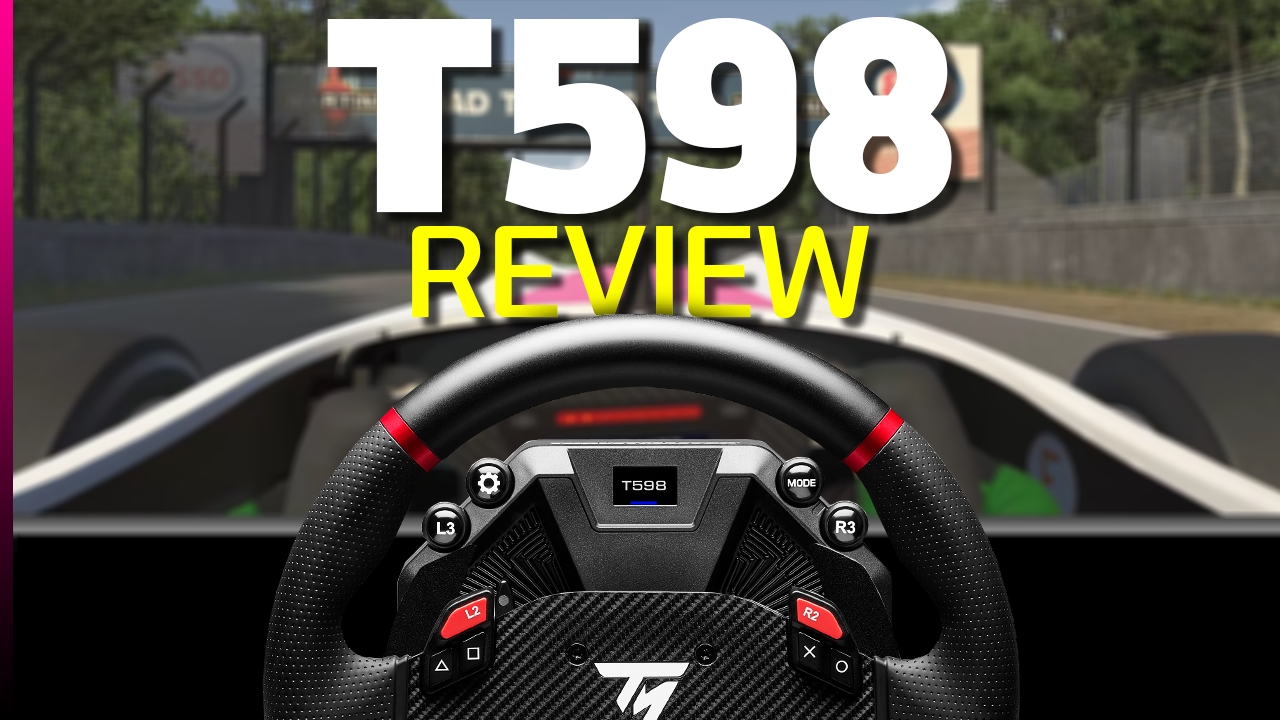




Chat with the Community
Sign Up To CommentIt's completely Free
How would you compare it to tgt 2 and dd pro 5nm and dd pro 8nm ? Which one would you recommend ?